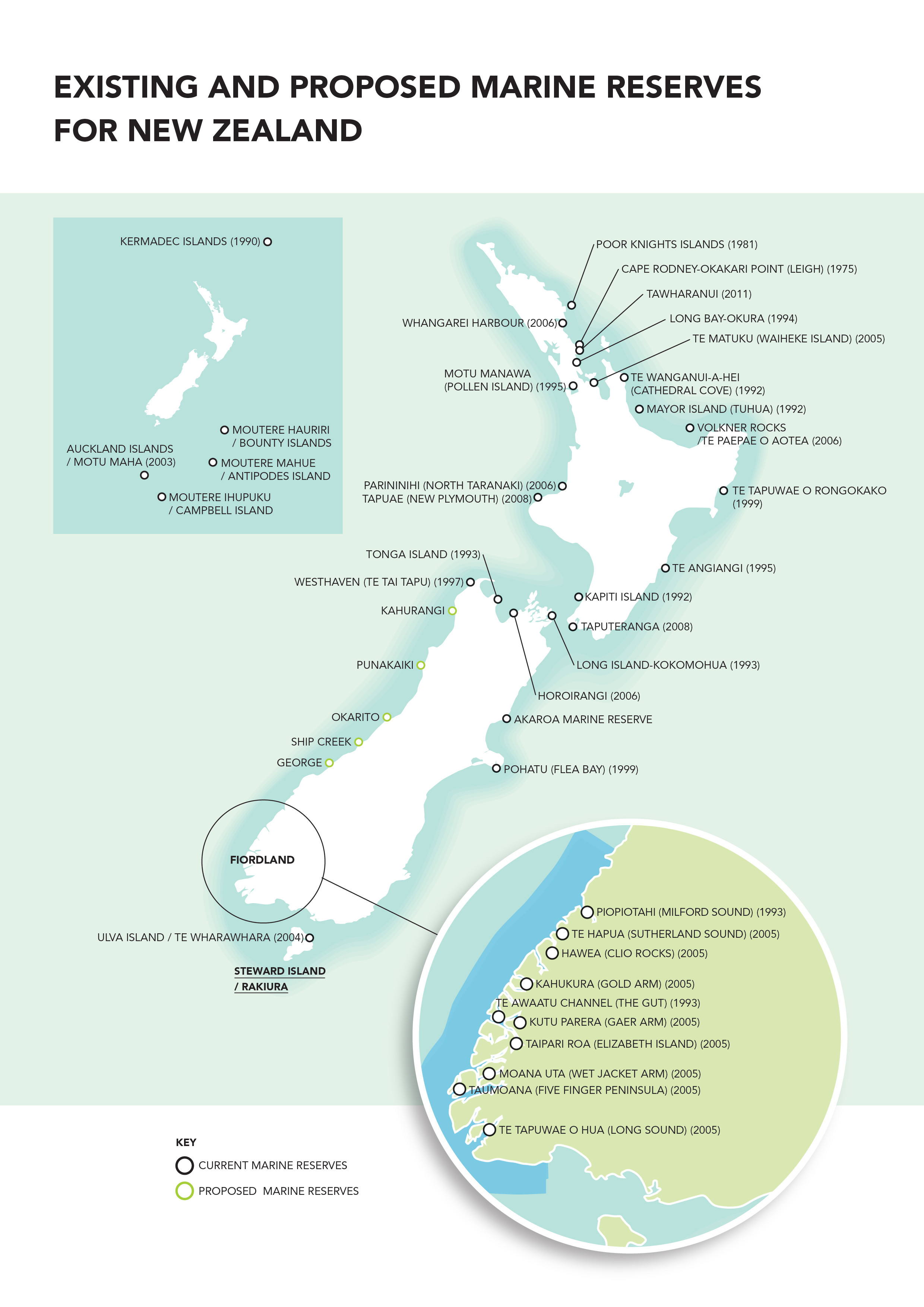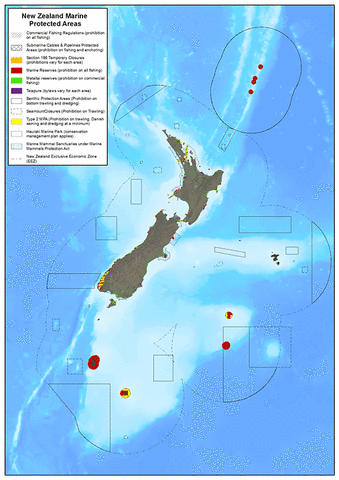 Marine Protection in New Zealand is in a period of change. For a long time there has been a desire to change the legislation. The Government in 2016 released a discussion document of its proposed changes in the form of a new marine protection bill. It is highly recommended that anyone interested in marine conservation study these proposed changes, but the final form of this legislation is not clear. There has been no report on this consultation released at the time of writing this page and there is no date set for introducing the legislation into Parliament.
Marine Protection in New Zealand is in a period of change. For a long time there has been a desire to change the legislation. The Government in 2016 released a discussion document of its proposed changes in the form of a new marine protection bill. It is highly recommended that anyone interested in marine conservation study these proposed changes, but the final form of this legislation is not clear. There has been no report on this consultation released at the time of writing this page and there is no date set for introducing the legislation into Parliament.
In the leu of major changes we are currently bound by the legislation of the Marine Reserve Act 1971 and the MPA Policy and Implementation Guide.
MPA Policy Summary
IMPORTANT: the MPA policy is not legislation, the policy guides government departments actions in establishing marine protection in NZ. Marine reserves and other protected area proposals can be prepared by non-government groups and regional forums for the purposes of marine protection.
Before 2005 the Department of Conservation was often an applicant for marine reserves and supported many groups in their applications. The use of government resources is now directed by the MPA Policy and Implementation Plan first published in 2005 with the goal to "Protect marine biodiversity by establishing a network of MPAs that is comprehensive and representative of NZ's marine habitats and ecosystems".
It's key components and the mechanisms as outlined in the MPA: Classification, Protection Standard and Implementation Guidelines 2008 are:
- a consistent approach to classification of the marine habitats and ecosystems based on the best scientific data is to be used to ensure representativeness of protection. Biogeographic region, marine or estuarine, depth, exposure and substrate type is used as a predictor of habitat and ecosystem in this classification system. Two examples using this classification system are: Marine Habitat Map of Northland: Mangawhai to Ahipara & Mapbook and A National and Regional Scale Gap Analysis of Marine Protected Areas
- guidelines defining a protection standard where a range of management tool/regime must provide for the maintenance and recovery of:
- physical features and biogenic structures that support biodiversity;
- ecological systems, natural species composition (including all life-history stages) and trophic linkages; and
- potential for the biodiversity to adapt and recover in response to perturbation.
 The government wants coordination of the MPA planning process in regional community based Marine Protection Planning Forums (MPPF) (MPA forum process) made up of stakeholder representatives that will be supported by DOC and MPI staff, and tasked to work towards consensus on a recommendation report to the Ministers within 18 months of their formation. The key steps to follow include:
The government wants coordination of the MPA planning process in regional community based Marine Protection Planning Forums (MPPF) (MPA forum process) made up of stakeholder representatives that will be supported by DOC and MPI staff, and tasked to work towards consensus on a recommendation report to the Ministers within 18 months of their formation. The key steps to follow include:
- Inventory to identify areas where MPAs are required;
Upon the formation of a MPPF in a region, MPI and DOC staff may be tasked to prepare reports which include an inventory of established protected areas and how they fit into the classification system.
- A nationally consistent basis for planning and establishing new MPAs;
A set of guidelines have been developed to guide each forum process, allowing for constructive engagement by tangata whenua, user groups and the public specifically for planning MPAs (not for fisheries management, aquaculture and Resource Management Act issues). The guidelines insist forum recommendations minimise the adverse impact on existing users of the marine environment and adhere to Treaty of Waitangi settlement obligations.
MPA forums (aka MPPF) have been carried out to the point of marine protection being gazetted in the Sub-Antarctic Islands, West Coast of the South Island and now Kaikoura. Forums are underway in 2017 for the Hauraki Gulf Spatial Plan and the Otago South Coast
See the below table for a summary of marine protection planning forums and community groups on their way towards marine protection. Last updated October 2015
| Location | Group Name | Purpose | Make up of the group | Date started | Progress to date | For more info |
| Kaikoura | Kaikoura Guardians: Te Korowai o Te Tai o Marokura | A registered charity independently established. Representatives from member organisations included: Takahanga Marae, Kaikoura Forest & Bird, Kaikoura Boating Club, PAU3 fishermen's association, CRAMAC5, Kaikoura charter fishermen, Eco tourism: Encounter Kaikoura & Whale Watch, Kaikoura Marine and Coastal Protection Society, Kaikoura set net fishers, Te Rununga o Ngai Tahu | 25th April 2005 | Gazetted in August 2014 | Kaikoura marine management information page on Department of Conservation Website | |
| Otago | South East Marine Protection Forum | To consider marine protection for the Otago coastline within the 12 nm limit from Timaru to Waipapa Point (Catlins) | 14 members (including chair) appointed on a government (DOC) established forum. Sectors include community (1), environmental (2), tourism (1), commercial (3) and recreational (2) fishing, marine science (1) and tangata whenua (3). | First meeting June 2014 | members elected & in deliberation meetings | www.south-eastmarine.org.nz |
| Auckland | Hauraki Gulf Marine Spatial Planning Group - Sea Change | To prepare a marine spatial plan that will inform how the Hauraki Gulf is used into the future | Stakeholder working group made up of 14 members from different interest groups in the gulf, working under the guidance of the project steering group made up of mana whenua, Auckland & Waikato Council, Hauraki Gulf Forum, Ministry of Primary Industries & Department of Conservation. Once the plan is published the steering group will form recommendations on how to incorporate the plan into to the relevant councils and agencies areas of jurisdiction. | First meeting December 2013 | in final stages of preparing stakeholder working group marine spatial plan | www.seachange.org.nz |
| Bay of Islands | Fish Forever | To protect 10% of the enclosed waters of the Bay of Islands as a network of marine sanctuaries | TA subcommittee of the Bay of Islands Maritime Park Incorporated Society made of volunteers from a wide variety of backgrounds | Subcommittee formed 2010 | Pre application: Marine Reserve Proposal released for submissions in July 2014 |
Today's marine protection tools that meet the marine protection standard as outlined in MPA Policy and Implementation Plan ">include:
- Marine Reserves Act 1971: No-take marine reserves are the highest form of biodiversity protection. Completely no-take with widespread benefits. Can also be created under special legislation.
READ MORE ON MARINE RESERVE BENEFITS
- Fisheries Act 1996: Customary tools Mātaitai, Taiapure are found in the Kaimoana Regulations in the Fisheries Act and a Rāhui (temporary closure) tool is available under section 186 the Fisheries Act to give practical tools and recognition of the rights guaranteed to tāngata whenua under the Treaty of Waitangi. These tools are the only parts of the Fisheries Act 1996 that have potential to provide ecosystem protection.
- Marine parks & marine management area special legislation NZ has one marine park at Mimiwhangata created under the Fisheries Act 1983 which excludes commercial fishing and has some recreational fishing limitations. The now current Fisheries Act 1996 does not give powers to create marine parks, so today they can only be created by special legislation such as the Hauraki Gulf Marine Park created in 2000.
READ MORE ON MARINE PARKS & SPECIAL LEGISLATION
- Benthic protection areas (BPA's) since 2007 1.2 million sq km of our exclusive economic zone's seabed (4 times the size of NZ landmass) has been closed to trawling and dredging, including seamounts and hydrothermal vents. It is expensive and difficult to get information on our deep sea's ecosystems. More work is needed to ensure representative ecosystem protection in the EEZ, including the pelagic environment.
READ MORE ON BENTHIC PROTECTION AREAS
- There are a handful of restrictions that may have a biodiversity protection effect like cable zones (must be no-take & no disturbance). Areas protected under the Submarine Cables and Pipelines Protection Act 1996 prevent all marine-based activities that may threaten undersea cables or pipelines. They can have the effect of protecting local species and habitat. If the positive effects are strong enough to meet the MPA standard, Cable and Pipeline Protection Zones could qualify for MPA status. To date there are no cable zones that qualify for MPA status.
- Some communities have combined these tools to enact locally based co-management, as well as enhance their marine reserve e.g. Kaikoura Marine Management Area & Te Tapuwae o Rongokako Marine Reserve
